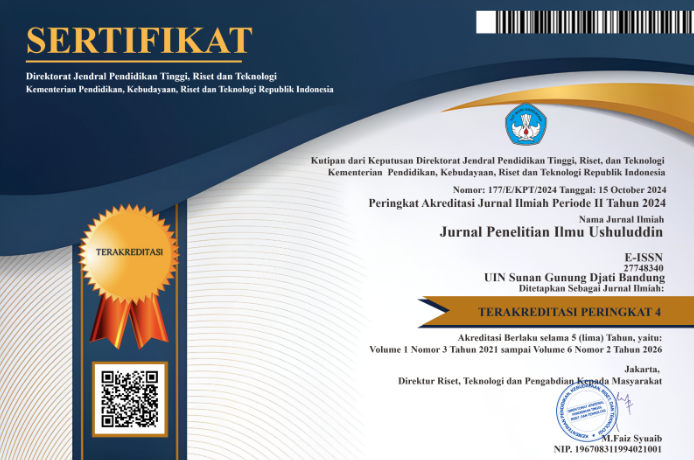Konsep Terapi Salat Menurut Perspektif Moh. Ali Aziz
DOI:
https://doi.org/10.15575/jpiu.16827Keywords:
Happiness, Prayer, Therapy.Abstract
Prayer is a work that is intended to worship based on predetermined conditions that begin with takbiratul ihram and end with greetings. Prayer is one of the commands from Allah that must be done by a Muslim. Prayer in addition to being an obligation, can be used as a therapy. Prayer therapy is a therapy that takes the essence of prayer and reading in prayer. These points come from the readings in the six prayer movements viz. Standing, Bowing, I'tidal, Prostration, Sitting between the two prostrations and Tasyahud at the beginning and at the end. The purpose of this study is to describe the views of Moh. Ali Aziz on the concept of prayer therapy. This research is a research that uses a qualitative method using a literature study. The analytical method used is descriptive content analysis technique. The results of this study show the happy prayer therapy written by Moh. Ali Aziz is a therapy by performing prayers and contemplating the points contained in the prayer movement which consists of standing, bowing, I'tidal, prostration, sitting between two prostrations and tasyahud. The results of happy prayer therapy can bring a servant closer to his Lord, and can get rid of all negative thoughts and turn them into positive thoughts so as to create peace of mind and happiness. The results of this study are very useful for someone who is experiencing problems or is not happy. The conclusion of this study is to invite all Muslims to contemplate and pray solemnly by contemplating the important points contained in each prayer movement.
References
Afifudin. (2012). Metode Penelitian Kualitatif. CV Pustaka Setia.
Agustin, N. (2019). Pengaruh Terapi Shalat Dhuha Dalam Mengurangi Kecemasan Karir Masa Depan. Surabaya: UIN Sunan Ampel Surabaya Press.
Ali Islam, A. H. (2006). Terapi Al-Quran Untuk Penyakit Fisik dan Psikis Manusia. Jakarta: Asta Buana Sejahtera.
Amar. (1982). Terjemahan Fathul Qarib. Semarang: PT. Pustaka Rizki Putra.
Aziz, M. A. (2013). 60 Menit Terapi Salat Bahagia. Surabaya: UIN Sunan Ampel Surabaya Press.
Aziz, M. A. (2017, 27 Desember Rabu). Biografi Prof. Dr. Moh. Ali Aziz, M.Ag. Retrieved from Terapi Shalat Bahagia: http://www.terapishalatbahagia.net/
Badri . (2006). Rahasia Shalat, Zikir & Doa yang bermakna . Jakarta: Qultum media.
Chaplin. (1995). Kamus Lengkap Psikologi, Terjemahan Dr. Kartini Kartono. Jakarta: PT Raja Grafindo Persada.
Darmalaksana, W. (2020a). Cara Menulis Proposal Penelitian. Bandung: Fakultas Ushuluddin UIN Sunan Gunung Djati Bandung.
Darmalaksana, W. (2020b). Metode Penelitian Kualitatif Studi Pustaka dan Studi lapangan. Bandung: Pre-Print Digital Library UIN Sunan Gunung Djati Bandung.
Hafizh, M. R. (2005). Menuju Shalat Sempurna. Bandung: Amanah Publishing House.
Hakim, L. (2015). Pengaruh Terapi Religi Shalat Dan Dzikir Terhadap Kontrol Diri Klien Penyalahgunaan Narkotika. Malang: UIN Maulana Malik Ibrahim Malang.
Hawwa, S. (2000). Mensucikan Jiwa . Jakarta: Rabbani Pers.
Lusiana, S. (2019). Bimbingan dan Konseling Islam Dengan Menggunakan Terapi Shalat Bahagia Dalam menangani Remaja Yang Kecanduan Game Online. Surabaya: UIN Sunan Ampel Press.
Malik. (2001). Malang Nian Orang yang TIdak Shalat. Jakarta: Pustaka Al Kausar.
Muhyiddin, A. (2006). Salat Bukan Sekedar Ritual. Bandung: PT Remaja Rosdakarya.
Nashr, A. M. (2011). Shalat Penuh Makna. Solo: Al-Qowam.
Nasution, L. (1999). Fiqh Ibadah. Jakarta: Logos Wacana Ilmu.
Nasution, R. F. (2018). Efektifitas Terapi Shalat Bahagia untuk menurunkan Anxiety Disorder Mahasiswa Kelas B3 Semester tujuh Program Studi Bimbingan Konseling Islam. Surabaya: UIN Sunan Ampel Press.
Puspa, Y. P. (2003). Kamus Umum Populer. Semarang: CV Aneka Ilmu.
Qira'ati, M. (2006). Pancaran Cahaya Shalat . Bandung: Pustaka Hidayah.
Rifa'I. (2003). Risalah Tuntunan Shalat Lengkap. Semarang: CV. Toha Putra.
Sayyid, S. (2004). Fiqh Sunnah. Jakarta: Pena Pundi Aksara.
Suharso, & Retnoningsih, A. (2013). Kamus Besar Bahasa Indonesia. Semarang: Widya Karya.
Syadi, K. A. (2008). Awwal Marrah Ushalli, Wakana Li Al Shalat Tha'Mun Akbar. Jakarta: Mirqat Publishing.
Teungku. (2000). Pedoman Shalat. Semarang: PT. Pustaka Rizki Putra.
Thayyar, A. A. (2006). Ensiklopedia Shalat. Jakarta: Maghfira Pustaka.
Zaini, A. (2015). Shalat sebagai Terapi bagi Pengidap Gangguan Kecemasan dalam Perspektif Psikoterapi Islam. Konseling Religi: Jurnal Bimbingan Konseling Islam, 6(2), 319-334.
Downloads
Published
Issue
Section
License
Authors who publish in Jurnal Penelitian Ilmu Ushuluddin agree to the following terms:
- Authors retain copyright and grant the journal right of first publication with the work simultaneously licensed under an Attribution-ShareAlike 4.0 International (CC BY-SA 4.0) License that allows others to share the work with an acknowledgment of the work's authorship and initial publication in this journal.
- Authors are able to enter into separate, additional contractual arrangements for the non-exclusive distribution of the journal's published version of the work (e.g., post it to an institutional repository or publish it in a book), with an acknowledgment of its initial publication in this journal.
- Authors are permitted and encouraged to post their work online (e.g., in institutional repositories or on their website) prior to and during the submission process, as it can lead to productive exchanges, as well as earlier and greater citation of published work (See The Effect of Open Access).












